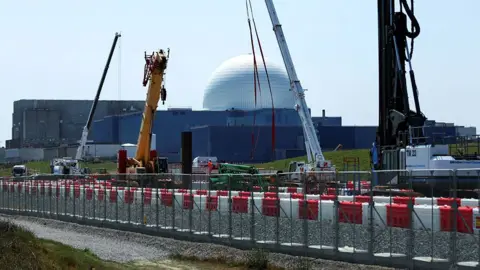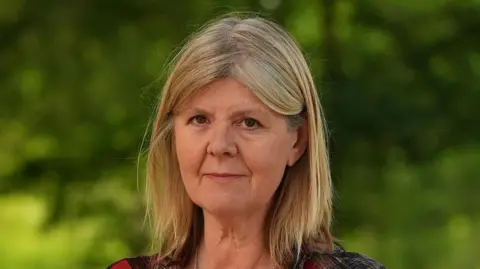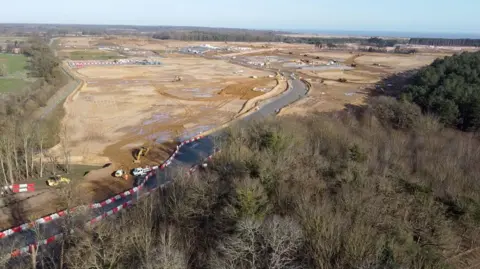Sizewell C nuclear power plant costs rise to £38bn

 Reuters
ReutersThe cost of building the Sizewell C nuclear power plant in Suffolk has jumped to £38bn, adding £1 a month to household energy bills for at least a decade.
The previous official figure for the project was £20bn, but the plant’s joint managing director Julia Pyke said earlier estimates did not account for inflation or risk.
The government confirmed on Tuesday that it would take a stake in the power plant, and announced that it had secured investment from a number of businesses, including British Gas-owner Centrica.
The Sizewell C reactor is expected to begin operating in the mid to late 2030s, said Ms Pyke, after which she estimated home energy bills would be £2bn lower.
Ms Pyke said the nuclear plant would “cost consumers about £1 a month during the construction phase,” adding up to a “small annual charge”.
The government’s stake in the project is 44.9%, while Centrica, EDF, La Caisse and Amber Infrastructure will also have holdings in exchange for funding.
Alison Downes, director of pressure group Stop Sizewell C, said the project had “only crawled over the line thanks to guarantees that the public purse, not private investors, will carry the can for the inevitable cost overruns”.
She added: “It is astounding that it is only now, as contracts are being signed, that the government has confessed that Sizewell C’s cost has almost doubled to an eye watering £38bn – a figure that will only go up.”
 Martin Giles/BBC
Martin Giles/BBCBut Tom Greatrex, chief executive of the Nuclear Industry Association, said it was “money well spent” and the project would create “thousands upon thousands of good jobs”.
Ms Pyke said Sizewell C’s design is “85% copied” from Hinkley Point C in Somerset, which she said meant the Suffolk project would be cheaper to build.
Hinkley Point C is the first new nuclear power plant under construction in the UK since the 1990s. It was initially forecast to be operational by 2017 at a cost of £18bn.
It is not expected to be completed for a further four to six years following pandemic-related delays, and is set to cost around £46bn.
Mr Greatrex said Sizewell C was the first “true replica nuclear power station.” He added it was “the best way to build faster and cheaper, and we must apply those lessons to a full programme.”
Sizewell C is expected to create 10,000 direct jobs, thousands more in firms supplying the plant and generate enough energy to power six million homes, the Treasury said.
Energy Secretary Ed Miliband said: “It is time to do big things and build big projects in this country again and today we announce an investment that will provide clean, homegrown power to millions of homes for generations to come.”
 Jamie Niblock/BBC
Jamie Niblock/BBCThe government’s National Wealth Fund – its principal investor and policy bank – will be making its first investment in nuclear energy.
The ownership of the Sizewell C nuclear power plant will be:
- UK government: 44.9%
- La Caisse: 20%
- Centrica: 15%
- EDF: 12.5%
- Amber Infrastructure: 7.6%
Chancellor Rachel Reeves said the multi-billion pound investment from La Caisee, Centrica and Amber was a “powerful endorsement” of the UK as “a global hub for nuclear energy”.
Despite the UK’s strong nuclear legacy, including opening the world’s first commercial nuclear power station in the 1950s, no new nuclear plant has opened in the UK since 1995, with all of the existing fleet except Sizewell B likely to be phased out by the early 2030s.
Sizewell C was one of eight sites identified in 2009 by then-Energy Secretary Ed Miliband as a potential site for new nuclear. However, the project was not fully funded in the 14 years that followed under subsequent governments.

Get our flagship newsletter with all the headlines you need to start the day. Sign up here.
Source link







